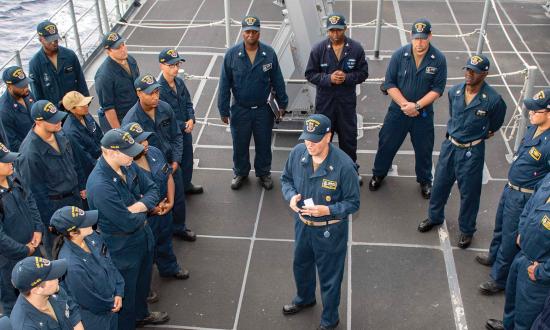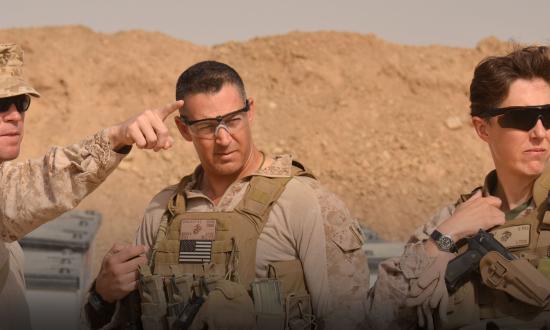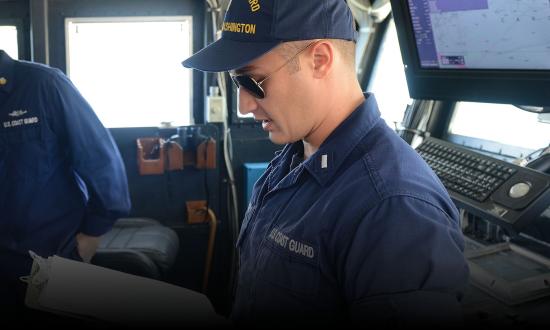Failure is not an option. Naval leaders—from the day they take their oaths—are inculcated with the idea that failure is not tolerated, “not on this ship, not in this squadron, not in this platoon, and not on my watch.” Failure-is-not-an-option leadership is a style generally celebrated in U.S. military and corporate cultures. Many believe it inspires excellence. The truth is, it probably does not.
At best, never-fail leadership institutionalizes mediocrity. At worst, it stifles creativity, inspires rote adherence to standardized procedures and timidity, and fosters an environment so dominated by a fear of failure that people may be more willing to compromise their integrity than face the consequences of honest mistakes. Leaders who do not embrace the f-word forfeit opportunities to practice graceful failure and, as a result, increase the likelihood that inevitable failures will be catastrophic.
The root of this problem is that Sea Service culture regards failure with fear and contempt, but mostly fear. Personal failures will not be tolerated. Subordinate failures will not be accepted. Team failures are unimaginable. Marines and sailors cheer the clarion call to perfection. Their bosses rest easy at night knowing they will be spared those “Sorry to wake you, but . . .” phone calls because they know the Sword of Damocles is permanently affixed above the skull of each trembling trooper.
Failure-is-not-an-option pronouncements may be stirring, but they also are unachievable and unhealthy. Without failure, there can be no success.
Never-Fail Is Fantasy
Good engineers are trained to assume failure. Every first-year engineering student knows that any nonequilibrium system—a category that includes all human-engineered systems—will degrade and ultimately fail. Armed with the knowledge that degradation and failure is a matter of when and not if, engineers focus on how. They attempt to forecast the moment of failure and then design their bridges, rockets, and computers so that when they degrade and fail, they will do so gracefully and not catastrophically. Graceful failures are anticipated, controllable, and, most important, they can be recovered from. Catastrophic failures, by contrast, are unmanageable and often disastrous.
Like engineers, military leaders design and manage nonequilibrium systems. But the systems they are entrusted with are much more complex—and therefore more fragile than anything engineered in the shipyard. The systems they lead are human social systems. A ship’s deck division, and a Marine rifle company, a SEAL platoon, a ship, a submarine, a squadron, a numbered fleet, a Marine expeditionary force are all human social systems subject to the same degenerative forces that assault mechanical systems. So, if the engineers are right, then no matter how well human social systems are designed or how assertively it is declared that they will not fail, they will fail.
Three Pathologies of Never-Fail Culture
Failure-is-not-an-option leadership spawns a culture that suffers from three pathologies. First, never-fail leadership discourages innovation. For any tactical or technical problem, there is a standard solution—the way the problem has always been addressed—and a best solution. Ideally, the standard solution and the best solution are one and the same. Often, however, they are not. The authors of the Navy’s “textbook solutions” could not foresee every situation. Furthermore, adversaries incessantly try to use these standard solutions against us. As a result, the standard solution, while always the safest course of action politically, may ultimately be the surest path to disaster and defeat.
Yet, regardless of whether the standard solution is the best, the safest, or perhaps even dangerous, sailors and Marines reach for the textbook solution every time if they fear they will be punished for an innovative approach that proves unsuccessful. Innovation is just too risky under never-fail leadership. Natural innovators under never-fail leaders stick to the “good enough” even when they know it really is not.
Second, failure-is-not-an-option leaders stifle ambition. The never-fail culture incentivizes mediocrity by introducing disincentives to try anything hard. Individuals and teams that have been taught to fear failure rarely explore new frontiers. As a result, they leave vast resources of human and corporate capacity unexploited. Never-fail leadership creates a top-down fear of attempting hard things and has a chilling effect on ambition and vigor. It stunts personal and organizational growth.
Finally, and most important, a never-fail culture increases the likelihood of catastrophic failures of honor by incentivizing lying, cheating, and stealing. When failure is not an option, personal ethics become negotiable.
A brief thought experiment illustrates how never-fail undermines honor. Imagine you are preparing for a difficult exam, and someone offers to sell you the answers at a reasonable price. Let us also stipulate you know the chance of being caught is essentially zero; only you and your answer-vendor will know you cheated. Presumably, you still would not purchase the answers. There really is no moral ambiguity here; this is a clear right versus wrong choice.
Would the calculus change if failure meant you would be passed over for promotion? Again, few would accept this as a valid justification to overcome the moral imperative of fair play. But what if this were your last chance? What if failure on this test would result in an early and unwelcome retirement? And what if you and your family were already living on the margins in a high-unemployment economy? This exam would now threaten the well-being of your family. Would you cheat now?
Again, perhaps not; most people guard their integrity fiercely. The point, however, should be clear. As the cost of failure increases, so too does the importance of succeeding, no matter what is required. In the final scenario, the nature of the moral question has fundamentally changed from a simple test of integrity to a genuine moral dilemma, a question of competing goods and lesser evils. The general moral obligation to play fair is at odds with the special moral obligation to care for one’s family.
A more difficult scenario takes us out of the realm of a thought experiment and into the real world. What if you witnessed a colleague purchasing the answers to the exam? Would you turn him or her in? The honor concept at the U.S. Naval Academy, and at many of the nation’s top universities, relies on a commitment from the student body to do precisely that. Yet many schools have discovered that their students’ commitment to their honor codes is surprisingly equivocal. The problem is that students feel the penalties for ethical failure that their institutions impose are too high, too lacking in nuance. They do not, in other words, buy into the school’s failure-is-not-an-option attitude toward honor.
When cheating scandals at service academies, Ivy League schools, and nuclear-missile commands make headlines, the public justifiably questions the character of the cheaters. But it may also be illuminating to investigate the culture in which the cheating occurs and, particularly, the price of failure in that culture. When service members perceive that the consequences of failure are dire, it is likely they will not fail. Indeed, they will do anything not to fail. They will even compromise their integrity.
Failure Is Feedback
Avoiding these pathologies and pitfalls starts with dispelling the myth that the failure-is-not-an-option approach to leadership drives great achievements. The truth is that it produces fewer successes than conventional wisdom suggests, and any achievements it does produce tend to be ephemeral. What endures is an uninspired workforce that seeks safety in middling accomplishments, fears change, and deals with honest mistakes by concealing them or deflecting blame.
Yet, accepting that failure is inevitable does not sound like an inspiring way to lead. On the surface, it sounds a bit defeatist. Even worse, it may suggest a degree of tolerance for failure that is counterintuitive—and, given the stakes we play for, dangerous. If leaders learn to embrace failure appropriately, however, the excellence that enables true success will follow.
Consider, for example, the Navy Special Warfare community. Although “I will not fail” is the final punctuation of the SEAL ethos, any SEAL worth his (and someday soon, hopefully, her) salt has failed many times. The special operations communities in all the services understand better than most that the only way to comprehend the limits of one’s capabilities is to explore them. When special operations units train, they flirt with and routinely cross frontiers of human and systemic failure, so that, like engineers, they can map those frontiers as precisely as possible. Failure is not defeat. It’s feedback. It’s data. It’s good.
The “I will not fail” declaration in the SEAL ethos is easily misunderstood. SEALs do not deny the inevitability of failure. Instead, they are taught to confront failures, learn from them, and ultimately overcome every failure they might face along the way to success. Better put, “I will not fail” means “I will not be defeated.”
Fail Gracefully, Succeed Wildly
Leaders can take positive measures to rehabilitate a never-fail culture and create one that allows failure, learns from mistakes, and instills an “I will not be defeated” mind-set.
First, leaders should examine the underlying tenor of the dialogue in their units, the corporate body language. Start with instructions and standing orders. They should minimize language such as “I will not tolerate” or “You will be held accountable for . . .” Of course, some language like this has its place. Clearly, there are behaviors and outcomes that warrant zero tolerance. But leaders should understand this language for what it is: These are threats. And when the “I will not tolerate” list expands to include lesser mishaps or even honest mistakes, the unintended and unhealthy consequences discussed above are predictable outcomes. Like profanity, such threats are effective only if they are used sparingly. Leaders cannot just talk the talk of risk tolerance, slinging around slogans such as “Be bold” and “Think outside the box”; they must walk the walk by persistently rewarding attempts to do things that are hard or innovative.
In addition, leaders should ask how the organization evaluates its readiness to accomplish its missions. Teams that fear the consequences of failure engineer self-evaluations in which “successful” outcomes are preordained. The Harlem Globetrotters win every time because they keep playing teams that get paid to lose. But it will not go well for the Globetrotters on the day the Golden State Warriors show up. To overcome a failure-is-not-an-option culture that embraces training scenarios and readiness exercises where you always win, leaders must demand realistic scenarios that challenge their teams to accept, understand, incorporate, and account for potential failures.
When leaders create such a culture, service members know that, regardless of outcome, a well-managed risk will be tolerated—and perhaps even rewarded and celebrated. They will approach problem-solving differently, preferring best solutions to standard solutions. They will try hard things, gather data from each of their failures, and breach barriers formerly deemed unbreachable. When people work in failure-tolerant environments, not only are they more likely to discover the best solutions to persistent problems, but because they are accustomed to working “off script,” they also are better prepared, intellectually and culturally, to respond to novel threats and opportunities.
Leaders who embrace the f-word set conditions for their subordinates to fail gracefully and, ultimately, to succeed in ways not previously imagined.








